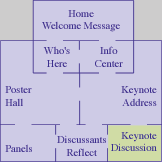Posted by:
Abigail Levy
Posted on: May 08, 2002 at 2:15 PM
Message:
Michael Fullan identified four conditions of sustainability and I wanted to comment on the first one, improving the social and moral environment (of the district, for example). This relates strongly to part of our findings of a study of sustainability that EDC's Center for Science Education is completing. (The study, Researching the Sustainability of Reform, focused on nine districts that have sustained hands-on elementary science programs for 10-30 years and was also mentioned by Jeanne Century in an earlier posting).One of our findings was a more refined definition of sustainability than we had when we began our research. We now think of it as the ability of a program to maintain its core beliefs and values and use them to guide program adaptations to changes and pressures over time. The emphasis on adaptability to changes and pressures grew directly out of our nine sites, and is the connection between our findings and Fullan's attention to the social and moral environment of a district. The notion of improving the social and moral environment of a district, although not something we saw within our study of sustained programs, points to two issues related to the environment of the district that we did see. First, embedded in the need to improve the environment of a district, is recognition of the importance of contextual factors to the sustainability of a program. In our research, we found critical contextual factors to be the values and institutions of the broader community, the culture of a district, its distribution of power and decision-making authority, and the value it places on equity. These are some of the sources of the powerful pressures that come to bear on programs and often cause their demise. Second, program leaders in the districts we studied did not change the many ways in which these factors exerted pressures on their programs. However, leaders did recognize their importance, learned how they interacted, and most importantly, learned how to function within their parameters. With this adeptness, leaders were able to make the multitude of decisions, large and small, that their programs require if they are to be sustained. The nine leaders recognized the power of these factors and were able to maneuver within the context created by them. This ability, informed by the program's core beliefs and values, enabled them to guide program adaptations to changes and pressures over time - sustainability.
|


